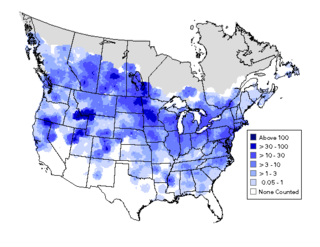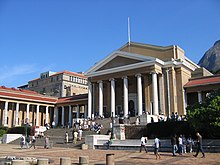Related Research Articles

Southern Africa is the southernmost subregion of the African continent, south of the Congo and Tanzania. The physical location is the large part of Africa to the south of the extensive Congo River basin. Southern Africa is home to a number of river systems; the Zambezi River is the most prominent. The Zambezi flows from the northwest corner of Zambia and western Angola to the Indian Ocean on the coast of Mozambique. Along the way, the Zambezi River flows over the mighty Victoria Falls on the border between Zambia and Zimbabwe. Victoria Falls is one of the largest waterfalls in the world and a major tourist attraction for the region.

The Cape vulture or Cape griffon, also known as "Kolbe's vulture", is an Old World vulture in the family Accipitridae. It is endemic to southern Africa, and lives mainly in South Africa, Lesotho, Botswana, and in some parts of northern Namibia. It nests on cliffs and lays one egg per year. In 2015, it had been classified as Endangered on the IUCN Red List, but was down-listed to Vulnerable in 2021 as some populations increased and have been stable since about 2016.

The African oystercatcher or African black oystercatcher, is a large charismatic wader resident to the mainland coasts and offshore islands of southern Africa. This near-threatened oystercatcher has a population of over 6,000 adults, which breed between November and April. The scientific name moquini commemorates the French naturalist Alfred Moquin-Tandon who discovered and named this species before Bonaparte.
QDGC - Quarter Degree Grid Cells are a way of dividing the longitude latitude degree square cells into smaller squares, forming in effect a system of geocodes. Historically QDGC has been used in a lot of African atlases. Several African biodiversity projects uses QDGC, among which The atlas of Southern African Birds is the most prominent one. In 2009 a paper by Larsen et al. describes the QDGC standard in detail.

The hadada ibis, also called hadeda, is an ibis native to Sub-Saharan Africa. It is named for its loud three to four note calls uttered in flight especially in the mornings and evenings when they fly out or return to their roost trees. Although not as dependent on water as some ibises, they are found near wetlands and often live in close proximity to humans, foraging in cultivated land and gardens. A medium-sized ibis with stout legs and a typical down-curved bill, the wing coverts are iridescent with a green or purple sheen. They are non-migratory but are known to make nomadic movements in response to rain particularly during droughts. Their ranges in southern Africa have increased with an increase in tree cover and irrigation in human-altered habitats.

The Southern African Foundation for the Conservation of Coastal Birds (SANCCOB) is an international body dedicated to seabird rehabilitation. The only seabird rehabilitation organisation registered with the South African Veterinary Council, the non-profit centre is based at the Rietvlei Wetland Reserve in Table View, South Africa.

The streaky-headed seedeater or streaky-headed canary is a small passerine bird in the finch family. It is an unobtrusive but widespread species in suitable habitats of southern Africa. Its presence in an area is revealed foremost by its callnotes.
Phillip Alexander Clancey was a leading authority on the ornithology of South Africa.

The African marsh harrier is a bird of prey belonging to the harrier genus Circus. It is largely resident in wetland habitats in southern, central and eastern Africa from South Africa north to South Sudan.

The Cape white-eye is a small passerine bird in the white-eye family. It is native to southern Africa. It is commonly found in suburbia, parks and gardens, besides a variety of mesic to well-watered habitats.

The Cape robin-chat is a small passerine bird of the Old World flycatcher family Muscicapidae. It has a disjunct range from South Sudan to South Africa. The locally familiar and confiding species has colonized and benefited from a range of man-altered habitats, including city suburbs and farmstead woodlots. It is an accomplished songster like other robin-chats, but is rather less colourful than most, and frequents either drier settings or higher altitudes. It forages in the proximity of cover, in the open or in fairly well-lit environments. Its distribution resembles that of the karoo–olive complex of thrushes, but it prefers the bracken-briar fringes of Afromontane forest, and does not enter far into forest proper. It is altitudinally segregated from the red-capped robin-chat, and is less of a skulker.

The white-throated robin-chat or white-throated robin is a species of bird in the family Muscicapidae. It is endemic to Botswana, Eswatini, Mozambique, South Africa, and Zimbabwe. Its natural habitats are dry savannah and subtropical or tropical dry shrubland.

The rosy-throated longclaw, also known as the rosy-breasted longclaw is a species of bird in the family Motacillidae. It is found in Angola, Botswana, Democratic Republic of the Congo, Kenya, Malawi, Mozambique, Namibia, South Africa, Tanzania, Zambia, and Zimbabwe. Its natural habitat is subtropical or tropical seasonally wet or flooded lowland grassland.

A bird atlas is an ornithological work that attempts to provide information on the distribution, abundance, long-term change as well as seasonal patterns of bird occurrence and make extensive use of maps. They often involve a large numbers of volunteers to cover a wide geographic area and the methods used are standardized so that the studies can be continued in the future and the results remain comparable. In some cases the species covered may be restricted to those that breed or are resident. Migration atlases on the other hand cover migratory birds depict maps showing summaries of ringing and recoveries.
BirdLife South Africa, formerly the South African Ornithological Society (SAOS), is the South African national partner organisation of BirdLife International.
SABAP2 is the acronym for the Southern African Bird Atlas Project 2, which is the follow-up to the Southern African Bird Atlas Project. The first atlas project took place from 1987 to 1991. The current project was a joint venture between the Animal Demography Unit at the University of Cape Town, BirdLife South Africa, and the South African National Biodiversity Institute (SANBI). Following the closure of the Animal Demography Unit, the project is now managed by the FitzPatrick Institute of African Ornithology, University of Cape Town. The project aims to map the distribution and relative abundance of birds in southern Africa, and the original atlas area included South Africa, Lesotho, and Eswatini, although since 2012 the project has expanded to include Namibia, Botswana, Zimbabwe and Mozambique. SABAP2 was launched on 1 July 2007. The field work for this project is conducted by more than 1700 volunteers, known as citizen scientists – they collect the data in the field at their own cost and in their own time. As such they make a huge contribution to the conservation of birds and their habitat.

Acraea acara, commonly known as the acara acraea, is a butterfly of the family Nymphalidae which is native to East and southern Africa.
The Pan-African Ornithological Congress (PAOC) is a regular conference on African ornithology, usually held every four years at an African venue. Its geographic scope is:
"...the entire continent from North Africa to the Cape of Good Hope, and east to the Suez Canal and Red Sea; the Cape Verde, Madeira and Canary islands; also isolated Atlantic Oceanic islands nearer Africa than South America, Antarctic islands south of Africa and the African-facing coast of Antarctica, the Seychelles, Comoros, Socotra, Mascarene Islands and Madagascar. All continental shelf islands are considered areas of interest, as are areas of provenance and intervening routes of migratory birds that visit Africa."
The Animal Demography Unit (ADU) is a formally recognized research unit of the University of Cape Town (UCT) located within the Department of Biological Sciences of UCT.. The Animal Demography Unit, popularly known as the ADU, was responsible for the management of the First and Second Southern African Bird Atlas Projects SABAP1 and SABAP2. The unit has submitted over eight million georeferenced biodiversity records to GBIF.
The South African Bird Ringing Unit (SAFRING) is based at the University of Cape Town and provides bird ringing services in South Africa and other African countries. This entails providing ringing equipment to qualified ringers, and curating all ringing data. SAFRING communicates with ringers and interested parties through annually publishing one or two issues of a newsletter, Afring News, and by maintaining a list server. SAFRING holds national training courses, annually if there is sufficient demand. SAFRING liaises with the provinces who have the responsibility of issuing permits. SAFRING has a strict code of ethics to ensure the safety of birds handled. SAFRING acknowledges the importance of bird ringing in that it has been described as the most important tool in ornithology in the 20th century.
References
- 1 2 3 Harrison, J.A., Allan, D.G., Underhill, L.G., Herrmans, M., Tree, A.J., Parker, V. & Brown, C.J. (1997) The Atlas of Southern African Birds. Vols 1 and 2, BirdLife South Africa, Johannesburg, South Africa
- 1 2 "THE ATLAS OF SOUTHERN AFRICAN BIRD : VOLUME 1: NON-PASSERINES" (PDF). Adu.org.za. Retrieved 2016-12-02.
- ↑ "SABAP2 | Welcome to the Southern African Bird Atlas Project". Sabap2.adu.org.za. Retrieved 2016-12-02.
- ↑ Harrison, J.A., Underhill, L.G. & Barnard, P. 2008. The seminal legacy of the Southern African Bird Atlas Project. South African Journal of Science 102: 82–84
- ↑ Barnes, K.N. (ed.) 1998. The Important Bird Areas of Southern Africa. BirdLife South Africa, Johannesburg.
- ↑ Barnes, K.N. (ed.) 2000. The Eskom Red Data Book of Birds in South Africa, Lesotho and Swaziland. BirdLife South Africa, Johannesburg.
